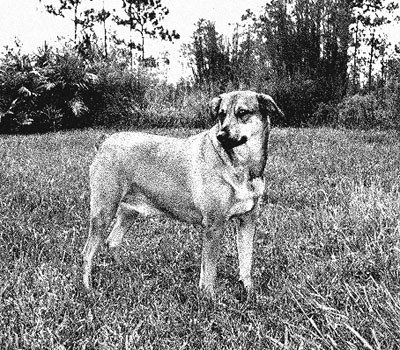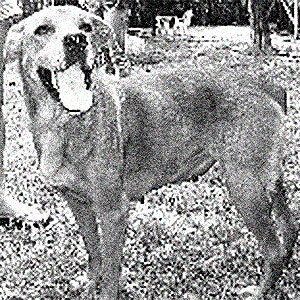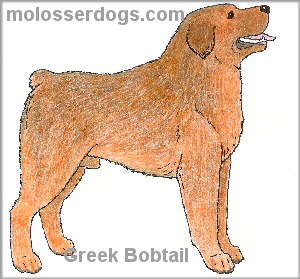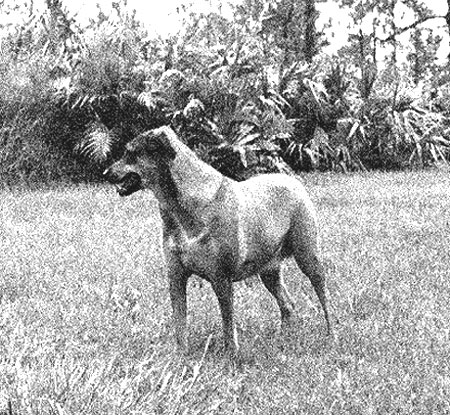Greek Cattledog

 The smallest and rarest of Greek Molossers, the Ellinikos Poimenikos Booeidon used to be a fairly common farm dog and companion found in rural areas, as well as some islands. It is sometimes given the misnomer "Greek Bobtail Herder", but this name can be misleading, since it is commonly applied to other shepherd breeds of Greece that have docked or naturally short tails, as well as to the population of working dogs belonging to a different type, being more collie-like in features. This specific variety described here is quite different and exists in modest numbers, showing a great deal of consistency in terms of appearance, with expected variations concerning the coat type. Although not recognized even in Greece, this lively, high-energy watchdog is bred to a consistent type and is believed to had been developed in the 19th century by crossing smaller specimens of local herders with the Alopekis and Meliteo Kinidio dogs, as well as imported hunting terriers and retrievers. The breed could best be described as either a pinscher type dog with strong sheepdog features or as a more or less typical Balkan working shepherd with pinscher-like appearance and personality traits. The Taurunum Dogge has also been suggested as one of its ancestors, possibly explaining the bully-like facial features of some strains. However, some fanciers dismiss this connection, suggesting that the Greek Cattledog is probably older than its northern Balkan cousin and has developed on its own thanks to the specific climate of its home region and the relative isolation from other influences. Whatever the case may be, this is an old indigenous breed and even though rare and fairly unknown, it is still a moderately popular and valued working dog in Greece.
The smallest and rarest of Greek Molossers, the Ellinikos Poimenikos Booeidon used to be a fairly common farm dog and companion found in rural areas, as well as some islands. It is sometimes given the misnomer "Greek Bobtail Herder", but this name can be misleading, since it is commonly applied to other shepherd breeds of Greece that have docked or naturally short tails, as well as to the population of working dogs belonging to a different type, being more collie-like in features. This specific variety described here is quite different and exists in modest numbers, showing a great deal of consistency in terms of appearance, with expected variations concerning the coat type. Although not recognized even in Greece, this lively, high-energy watchdog is bred to a consistent type and is believed to had been developed in the 19th century by crossing smaller specimens of local herders with the Alopekis and Meliteo Kinidio dogs, as well as imported hunting terriers and retrievers. The breed could best be described as either a pinscher type dog with strong sheepdog features or as a more or less typical Balkan working shepherd with pinscher-like appearance and personality traits. The Taurunum Dogge has also been suggested as one of its ancestors, possibly explaining the bully-like facial features of some strains. However, some fanciers dismiss this connection, suggesting that the Greek Cattledog is probably older than its northern Balkan cousin and has developed on its own thanks to the specific climate of its home region and the relative isolation from other influences. Whatever the case may be, this is an old indigenous breed and even though rare and fairly unknown, it is still a moderately popular and valued working dog in Greece.

 The Greek Bobtailed Cattledog is a tireless and resilient worker and, unlike the majority of livestock breeds of its homeland, this is primarily a herding dog, used for both driving and guarding cattle. Playful and trainable, this rugged breed makes a good family pet, but can become overly protective around strange people and dogs. Puppies are born without tails, hence the name of the breed, although a very small number of naturally long-tailed specimens can be seen. This is a squarely built dog, with a straight back, sturdy legs and a deep chest. Depending on the individual dog's bloodline, the head can have either a narrow or a wide muzzle, as well as ideally being balanced between the two types. Only solid-coloured dogs are kept alive and bred, with the fawn shades being preferred, even though examples having white markings and differently coloured coats can be seen in some regions.
The Greek Bobtailed Cattledog is a tireless and resilient worker and, unlike the majority of livestock breeds of its homeland, this is primarily a herding dog, used for both driving and guarding cattle. Playful and trainable, this rugged breed makes a good family pet, but can become overly protective around strange people and dogs. Puppies are born without tails, hence the name of the breed, although a very small number of naturally long-tailed specimens can be seen. This is a squarely built dog, with a straight back, sturdy legs and a deep chest. Depending on the individual dog's bloodline, the head can have either a narrow or a wide muzzle, as well as ideally being balanced between the two types. Only solid-coloured dogs are kept alive and bred, with the fawn shades being preferred, even though examples having white markings and differently coloured coats can be seen in some regions.
The medium-short, densely undercoated hard coat comes in shades of wheat, fawn, red and brown, preferably with a dark mask. The black "saddle" on the back, as well as brindle, black-n-tan and grey colourings are rarely encountered, being undesired and seen by some as signs of impurity. Wire-haired bearded examples are common, as are dogs that have a very short smooth coat. Average height is around 20 inches, but smaller specimens exist.
